Organizational Structure as Risk to Long-term GIS Success
There are two commonly recognized paths an organization can take in developing a GIS support strategy: "Build" or "Buy." Going down the Build path, an organization makes the commitment to build the expertise and capacity within the organization to deliver services to its GIS user community. On the other end of the spectrum is the Buy path, wherein an organization outsources the delivery of support to external service providers, with the organization only functioning in the vendor management role. Figure 1 shows a Build scenario.
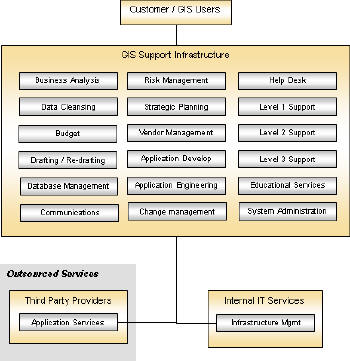 |
With the Build model, the organization's commitment to building the necessary expertise in-house brings costs and risks. A recent deployment of a nationwide GIS application with which we assisted required a support team of 15 full-time members, and supported almost all aspects of the application. A full range of skills were necessary, including customer relationship management, business analysis, program/project/deployment management, software development (specific to the application core product), database management, performance management and vendor management. Added to the expense will be the standard operating costs of maintaining employees, including the necessary on-going training and development.
The Build model can break down when an organization does not recognize the full cost of maintaining an ongoing training plan. Training is either not budgeted for future operating support costs, or is one of the first items to be cut from budgets. Also, there are risks associated with building and maintaining a highly specialized team. The primary risk is commitment to a particular platform or core product - what happens if the organization wants to change core products? What to do with a team fully trained and experienced on the old product? Retrain them or replace them? Obviously it gets complicated quickly.
Now let's look at the Buy model, illustrated in Figure 2. For this discussion we are assuming a Buy model that outsources the entire support infrastructure to external service providers.
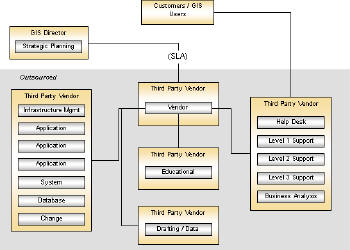 |
The Buy model pushes the cost of training and maintaining specialized personnel off to the service providers. The Buy model also mitigates the risk of being tied to a specific core product; the organization can switch external service providers if the decision is made to switch core products. These cost and risk mitigation benefits do come at a cost, including a potentially higher price. While this scenario mitigates some risks brought on by the Build model, it creates others, specifically the risk of poor customer service if clear, enforceable service level agreements (SLAs) are not put in place.
In the real world, a switch to a complete Buy model as shown is not common. It is too drastic a change for many organizations, which see this model as a risk to the intellectual property and competitive advantage they have gained in their industry. Also, many organizations do not have the skills and experience to manage vendors as rigorously as is required for this model to be successful.
Obviously there are pros and cons to each of the models. The challenge is to design a viable organization that allows the benefits of each option to be achieved while mitigating the associated risks.
A critical step before designing a GIS support infrastructure is to define the characteristics the infrastructure needs to successfully support and deliver value to the GIS users.
Putting aside the discussion on possible organization designs for a moment, let's look at the characteristics of a successful GIS service and delivery organization. The GIS support infrastructure (people, processes, technologies) should be:
- Agile - allowing it to respond to shifting technology and business needs by changing the required mix of competencies quickly
- Innovative - taking advantage of new technologies and best practices as they develop in the marketplace
- Risk averse - by sharing risk with vendors and internal business partners appropriately
- Collaborative - leveraging expertise in the marketplace and internal business partners
- Commercially driven - building metrics and controls into commercial contracts with vendors to effectively manage accountability and quality of service
- Service-based - maintaining a consistent focus on service quality to the customer
- Business-focused - retaining and fostering domain expertise relating to strategy and business goals of the organization
Bridging the Build and Buy models would yield a "Hybrid" model, taking advantage of external expertise and capacity while maintaining control and business focus within the organization. Many organizations have found value in the Hybrid model, and have reacted by adopting a Service Management Organization (SMO). The SMO model selects aspects from the Build and Buy models to create a streamlined, business-focused support team within the organization, managing the delivery of the expertise and capacity of external service providers. Figure 3 shows one of many possible interpretations of the SMO model.
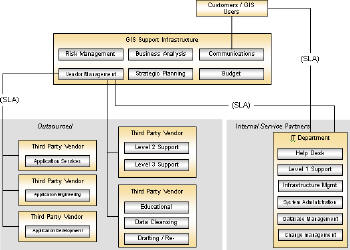 |
In the Hybrid model, the organization puts in place a small, customer-centric (vs. technology-centric) team. Through clear, enforceable SLAs, this team manages the delivery of services from external service providers: application/user support, application development/engineering, training/education, higher level support (beyond basic help desk support), and data/redrafting services. It also manages the delivery of services from other internal service partners, such as an internal IT organization that provides network/system/database administration and appropriate levels of support.
The strength of the Hybrid model is its ability to bring in the best service providers to address customer needs, whether it is contracted software developers proficient in your core development environment, or an internal IT organization that is already providing support and hosting services. This ability to change vendors as needed (or desired) also gives the SMO a huge amount of leverage over service providers when negotiating cost and/or SLAs.
Organizational options vs. desired characteristics
Taking the characteristics we defined above and comparing them across our three organizational options, we find that the Hybrid model, with its flexibility to select vendors and technologies as needed, meets all the criteria we defined.
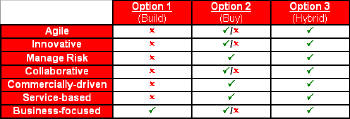 |
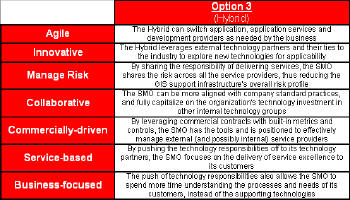 |
From a delivery point of view, we have found that a hybrid SMO model for GIS support can successfully deliver value and service excellence to the GIS user community. If properly designed and implemented, the SMO can also provide value to the organization in the following ways:
- Cost management - Through the SMO model, services are delivered based on clear commercial contracts that can be accurately budgeted in financial forecasts.
- Resource management - The SMO model allows for peaks and troughs in business, and changes in business requirements to be absorbed by service providers, alleviating the need for growth and/or reduction of internal staff size.
- Quality control - Quality of service is rigorously monitored and measured to ensure service excellence, with enforceable SLAs providing leverage to negotiate service costs and performance expectations.
- Strategic Positioning - The SMO allows the organization to be flexible enough to align with future outsourcing or insourcing direction for services.